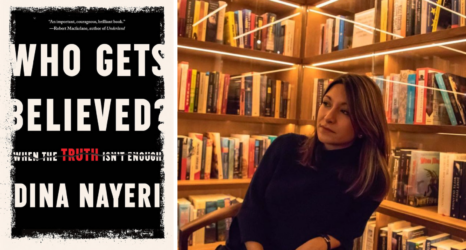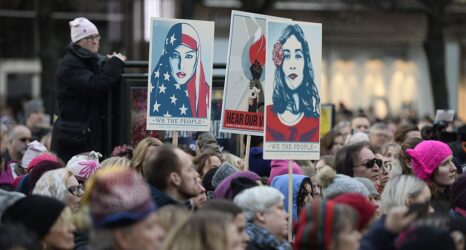The presidential race has fueled raging debates around feminism and misogyny in America. The idea of a woman breaking this glass ceiling has inspired many, but also revealed deep generational fissures in how women view feminism today. In the national security space, the election could usher in the first female commander-in-chief. Yet, we may already be at a tipping point on women’s participation throughout national security ranks, with more and more women entering and filling critical roles. What does this mean for these institutions and the national security policies they create? Just as feminism has become central in this election, it may also become increasingly important in national security as women wield more power in policymaking and determine what it means to be a feminist in these positions. Will women choose to use their voices and influence to push for needed change?
Even though the navy blue suits are still the overpowering visual in many national security meetings around Washington, something has been shifting for a while—a quiet progression of women into top rungs of leadership. There have been three female secretaries of state. In the Pentagon, the Obama Administration appointed the first woman—Michèle Flournoy—in the role of under-secretary of policy, the highest-ranking civilian position (and she was later followed by another woman, Christine E. Wormuth, in this role).
Women have taken the helm of military branches (e.g. secretary of the Air Force), and combat roles are now open to women for the first time in America’s history, which opens even more paths to military advancement. There are scores of women at senior levels throughout our national security agencies. Congresswomen and women staffers lead congressional committees tasked with appropriations and oversight of national security. Smart, accomplished national security thinkers who happen to be women are becoming the norm.
Despite this progress, there are still ingrained gender biases at play inside the closed, interconnected national security community. The problem cuts two ways: inside national security organizations and within the policies that they produce. First, the cultures in the organizations that make and influence national security are at best oblivious and at worst sexist in their reactions to gender issues, resulting in a steady but often unrecognized female exodus that begins at the mid-career level, just as women are poised to take on more leadership roles. The second problem is that the persistent but underlying gender biases in policymaking processes are preventing the formation of a more inclusive and progressive national security vision that could ultimately improve global stability.
The U.S. national security community has been deeply resistant to a meaningful discussion of gender, except when left with no other choice (e.g. sexual violence in the military and women in combat, and in those cases it took significant outside pressure to enact change). Granted, there have been some recent internal policy improvements. In January, the secretary of defense announced expanded maternity leave and other family benefits for members of the military (unfortunately, this did not apply to women in the civilian defense workforce). There also have been pockets of activity focused on mentoring the next generation of women, networking among women and building women’s leadership skills in national security. However, they are usually internal and informal, and are not supported by national security leadership beyond half-hearted approval. Women have been more than willing to share general advice. But most of the time, these events have not delved into the thornier issues of gender bias or the hard trade-offs of these career paths. Only behind closed doors do those challenges emerge fully and honestly. Those conversations have revealed some simmering frustrations among women, especially those at the mid-level: the perception that male colleagues are benefiting from more sponsorship, more visibility opportunities, more promotions and higher salaries.
Research confirms their suspicions. Countless studies have shown that women are experiencing implicit bias on a regular basis in most work environments, and that across industries there is a leaky-pipeline problem when it comes to women rising to the top. This is also the case in national security, as Women in International Security (WIIS)—an organization devoted to women’s advancement in these careers—has demonstrated in its reports based on hundreds of interviews across the field. Even with the increasing participation of women in this workforce, the senior executives, boards and advisory bodies at the top of national security institutions and esteemed think tanks remain old, white and male.
There are also broader and more far-reaching gender implications of the current national security culture. Gender is central to security. This fact is hard to miss today: Merely look at the rise of extremist ideologies that fixate on women’s oppression and the prevalence of gender-based violence in conflict and its aftermath for some horrific examples.
There has been some increased understanding of these gender dimensions in recent years, which has a lot to do with individual champions—both women and men—in senior leadership who have been willing to push the agenda. A cohort of leaders in key agencies and the White House, aided by nongovernmental advocates on the outside, successfully got the United States to enact the first National Action Plan on Women, Peace, and Security in 2011. This plan, anchored by an executive order, recognizes the critical roles that women are playing in conflict resolution, and requires the U.S. government to integrate women and gender into policies to prevent and respond to instability and violence around the world. The fact that numerous U.S. agencies were involved in drafting and agreeing to this document shows that some well-placed and powerful champions within the national security structure can drive needed change.
And yet, the daily business of national security policymaking has remained stubbornly resistant to realizing this vision. The majority of the national security community has remained un-swayed by emerging data from researchers, such as Valerie Hudson, that shows a clear correlation between gender equality and stability across countries and regions. “Insider” discussions that shape policy blatantly exclude gender as a low-priority issue, while mainstream security institutions lack even the most basic gender expertise or interest. In a few cases, influential national security agencies and think tanks have some program or initiative on women, but in most others there is no inkling of how gender is affecting security for more than half of the world’s population.
One obvious solution to gender bias is to get more women into senior positions in national security. But so far that has been inadequate. Although there are women (and men) who have championed these issues across the policy community, the uncomfortable fact is that higher numbers of women have not translated into a sustained movement for gender sensitivity in national security.
Women in national security fields are not wilting violets, nor are they wallflowers. Sheryl Sandberg would be proud—women in Washington D.C. certainly are leaning in on national security. But where they are not leaning in is to push a bigger and more transformative agenda inside their organizations. Even those who have achieved tremendous success often remain reticent about their gendered experiences in this workforce, and can even be fairly skeptical of the impact gender sensitivity could have on the effectiveness of U.S. national security policies.
One explanation for why this is true may be that women have not reached “critical mass”—in other words, the percentage of women in top national security positions is still too low to see the effects of their participation. According to the research by WIIS, the number of women in senior national security positions is still hovering under 30 percent in many agencies and offices. Below 30 percent, members of an underrepresented group will rarely self-identify or advocate for that group. This may partly explain why women are so reluctant to speak out on gender gaps.
Women are also reacting to concerns about professional reputation. Even with years of professional advancement and “proving themselves,” women still remain very insecure in professional standing. Research shows that women struggle with ongoing concerns about establishing and maintaining credibility, and interviews with women in the national security field show this is a heightened concern in this community. Many women have shied away from any focus on their sex, expressing a desire to be viewed solely as experts on substantive, serious national security topics. This is understandable, but it has its consequences.
The insecurities have a spillover effect on how women interact with other women in the workplace. Women have not had a history of strong mentorship of other women, although this is changing for the better as new generations increasingly view it as a core principle. Even so, research indicates that women continue to face gender-based obstacles in trying to access and benefit from “sponsors”—the people who have powerful positions, influence and networks, who help others obtain advancement opportunities. The majority of successful women have been sponsored by men unsurprisingly, since men have generally been in the positions to wield influence. But many women at senior levels of national security also acknowledge a hesitancy to more visibly help women because they are afraid that they will be considered too biased towards assisting women over men, which in turn affects reputation and credibility.
And all of this is just on the inside of the organizations. There is an embedded and powerful stigma attached to advocating for women or gender issues in external-facing national security policies. There is a spectrum of debate about policy—heated disagreement over the best strategy on Syria, how to deal with China and Russia, what to do about the global refugee crisis—and these arguments, within certain policy frameworks, are acceptable, even expected. But raising gender in policymaking, especially national security, is often a bridge too far. Such inquiries could unearth some uncomfortable questions: Who is invited to the table? Whose voices and opinions count? What does security mean and how might it be different for women and men? Opening a Pandora’s Box about gender and inclusion might lead the community to think about failures of policy, unintended consequences, and whether decision-making in Washington and many other parts of the world is really protecting the security of the people who need it most.
More than a few women in the national security field have said that they don’t want to be “that woman” in the organization—the one who always points to the women issues. Others have pointed out that demonstrating a commitment or expertise on gender in peace and security can be a “career killer.” It’s not surprising that women would not want to be the ones launching this conversation.
And yet, this really should be the next frontier of women’s leadership—because cracking the glass ceiling is no longer enough. The need to start taking gender seriously is too urgent—just ask the women in many countries who are working tirelessly to protect some basic level of security and equality. Although women may not see themselves as “gender experts,” women can raise the call for more integration of different perspectives and voices. If they don’t, who else will? Men can be strong allies, even leading efforts for gender equality. But they are not women. Thus, men will usually remain on the sidelines until called to action by their female colleagues. It is far more powerful for women themselves to be the ones to draw attention to the status of women—within their own organizations and globally.
Here is something to ponder: What would national security look like—national security leaders, institutions and the resulting policies—if women and men in Washington actually took these issues seriously and approached them strategically? The possibilities are powerful. Women (and, yes, men too) rising through the ranks of our national security community can and should start to break the silence.
Get Ms. in your inbox! Click here to sign up for the Ms. magazine newsletter.
Photo of Michèle Flournoy courtesy of the Chairman of the Joint Chiefs of Staff on Flickr, licensed under Creative Commons 2.0





